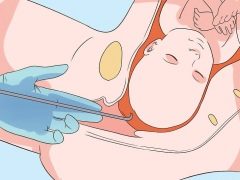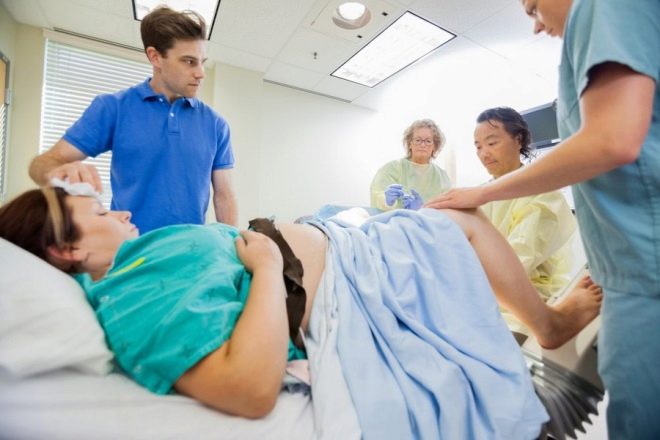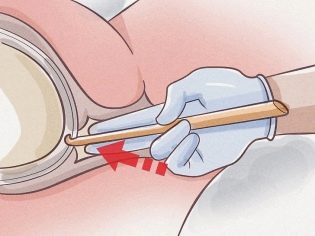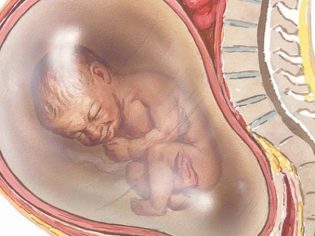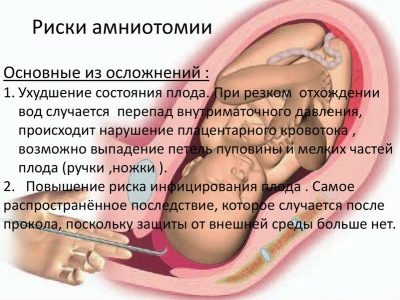Bubble puncture for labor induction
Many women who are preparing to become mothers have heard that the puncture of the fetal bladder is a very effective measure for labor induction and acceleration of the labor process. What is such a procedure, to whom and when it is carried out, we will describe in this article.
What it is?
During the entire pregnancy, the baby is inside the fetal bladder. Its outer layer is more durable, it is a reliable protection against viruses, bacteria, fungi. In case of violation of the mucous membrane in the cervical canal, he will be able to protect the child from their harmful effects. The inner lining of the fetal sac is represented by the amnion, which participates in the production of amniotic fluid - the very amniotic fluid that surrounds the child during the entire period of intrauterine development. They also perform protective and shock-absorbing functions.
Fetal bladder opens during natural childbirth. Normally, this happens at the height of active labor contractions, when cervical dilatation is from 3 to 7 centimeters. The opening mechanism is quite simple - the uterus contracts, with each contraction the pressure inside its cavity rises. It is this, as well as the special enzymes that the cervix produces at the time of expansion, and it affects the fetal membranes. The bubble is thinning and bursting, the waters are flowing away.
If the integrity of the bladder is disturbed before contractions, then this is considered a premature discharge of water and a complication of labor. If the opening is sufficient, the attempts begin, and the fetal bladder did not even think to burst, this may be due to its anomalous strength. It will not be considered a complication, because at any time doctors can perform its mechanical piercing.
In medicine, puncture of the fetal bladder is called "amniotomy." Artificial violation of the integrity of the fetal membranes allows you to release an impressive amount of biologically active enzymes contained in the waters, which acts obstructive. The cervix begins to open more actively, contractions become stronger and more intense, which reduces the time of delivery by about a third.
In addition, amniotomy can solve a number of other obstetric problems. So, after it can stop bleeding with predlagayuschey placenta, also this measure significantly reduces blood pressure in women with hypertension.
Bubble pierce before childbirth or childbirth. Before cesarean section, the fetal bladder is not touched, its incision is made already during the operation. The right to choose a woman is not given because the procedure is carried out only if there is evidence. But doctors must ask consent to an amniotomy.
Opening a bubble is a direct intervention in the affairs of nature, a natural and independent process, and therefore it is strongly not recommended to abuse them.
How is it done?
There are several ways to open the membranes. It can pierce, incise or break manually. It all depends on the degree of cervical dilatation. If it is open for only 2 fingers, then a puncture would be preferable.
There are no nerve endings, pain receptors in the fetal membranes, and therefore amniotomy is not painful. Everything is done quickly.
30-35 minutes before the manipulation, the woman is given in pills or injected intramuscularly with an antispasmodic. For manipulation, which the physician does not need to do, it is sometimes quite experienced obstetrician.A woman lies on a gynecological chair with her thighs divorced.
The physician inserts the fingers of one hand in a sterile glove into the vagina, and the sensations of the woman will not differ from the usual gynecological examination. With his second hand, the paramedic inserts a long thin instrument into the genital tract with a hook at the end of the branch. With her, he hooks the fetal shell when the cervix is ajar and gently pulls on itself.
Then the instrument is removed, and the obstetrician expands the puncture with his fingers, ensuring that the water flows away smoothly, gradually, because their rapid outflow can lead to leaching and loss of body parts or the umbilical cord into the genital tract. About half an hour after amniotomy is recommended to lie. CTG sensors are installed on the woman's stomach to monitor the state of the baby in the womb.
The decision to conduct an amniotomy can be made at any time of birth. If the procedure is necessary for childbirth to begin, then they talk about premature amniotomy. To enhance contractions in the first stage of labor, an early amniotomy is performed, and to activate contractions of the uterus during the almost complete opening of the cervix, free amniotomy is performed.
If the baby decided to be born “in a shirt” (in a bladder), then it is considered more reasonable to carry out a puncture at the moment of passing the baby through the birth canal, since such births are dangerous with possible bleeding in a woman.
Indications
Amniotomy is recommended for women who need to induce childbirth. So, with preeclampsia, post-term pregnancy (after 41-42 weeks), if independent deliveries do not begin, piercing the bladder will allow them to be stimulated. With a weak preparation for childbirth, when the preliminary period is abnormal and delayed, after the piercing of the bladder, in most cases, the bladder begins in 2-6 hours. Births are accelerating, and after 12-14 hours you can count on the birth of a baby.
In births that have already begun, indications may be as follows:
- cervical dilatation is 7-8 centimeters, and the fetal bladder is intact, it is considered impractical to preserve it;
- weakness of labor forces (contractions suddenly weakened or stopped);
- high water flow;
- flat bladder before childbirth (shallow water);
- multiple pregnancy (in this case, if a woman bears twins, the fetal bladder of the second child will be opened after the birth of the first in 10-20 minutes).
It is not customary to open the bubble specifically. It is also important to assess the degree of readiness of the female body for childbirth. If the neck is immature, the consequences of early amniotomy can be deplorable - weakness of labor, fetal hypoxia, a severe anhydrous period, and as a result, an emergency cesarean section in order to save the lives of the child and his mother.
When can not?
Even if there are weighty and respectful indications for amniotomy, the bubble will not be pierced for the following reasons:
- the cervix is not ready, there is no smoothing, softening, assessment of its maturity - less than 6 points on the Bishop scale;
- a woman has an exacerbation of genital herpes;
- the child in the mother's womb is positioned incorrectly - it is presented with legs, it is booty or lying across;
- placenta previa, in which the exit from the uterus is closed or partially blocked by the "children's place";
- umbilical hinges are attached to the exit of the uterus;
- the presence of scarring on the uterus in more than two;
- narrow pelvis, not allowing you to have a baby by yourself;
- monochorial twins (children in one fetal bladder);
- pregnancy after IVF (cesarean section is recommended);
- condition of acute oxygen deficiency of the fetus and other signs of trouble according to the results of CTG.
An obstetrician or a doctor will never undergo an autopsy of the fetal sac if the woman has indications for operative delivery — a cesarean section, and natural childbirth can be dangerous for her.
Possible difficulties and complications
In some cases, the period following the amniotomy proceeds without contractions.Then, after 2-3 hours, they begin to stimulate with medications - they inject Oxytocin and other drugs that strengthen the uterine contractions. If they are not effective, or if the contractions do not normalize within 3 hours, a cesarean section is performed for emergency reasons.
As already mentioned, a mechanical puncture or rupture of the membranes is an outside intervention. And because the consequences can be very diverse. The most common:
- rapid delivery;
- the development of weakness of generic forces;
- bleeding when a large blood vessel is located on the surface of the bladder;
- loss along with flowing waters of umbilical cord loops or fetal body parts;
- sudden deterioration of the child’s condition (acute hypoxia);
- the risk of infection to the baby, if the tools or hands of the obstetrician were not treated sufficiently.
If the procedure is carried out correctly, and in compliance with all requirements, most of the complications can be avoided, but it is difficult to predict in advance how the uterus will behave, whether the contractions will begin and whether the necessary contractions will begin at the right pace.
Reviews
According to women, amniotomy is really painless, many say that they almost did not pay attention to the manipulation of the doctor and guessed what happened only after the sac of sac had pierced and water had gone.
Some doctors, according to women, do not resort to obtaining consent for the procedure in patients and pierce the bubble arbitrarily when they consider it appropriate.
Most women note that delivery after a puncture went faster, contractions became stronger, and in some cases labor activity was activated already 30-40 minutes after amniotomy.
About why pierce the amniotic bubble, see the next video.
